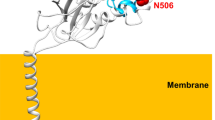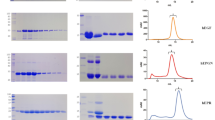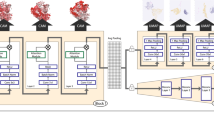Abstract
CD97 belongs to the adhesion GPCR family characterized by a long ECD linked to the 7TM via a GPCR proteolytic site (GPS) and plays important roles in modulating cell migration and invasion. CD97 (EGF1-5) is a splicing variant of CD97 that recognizes a specific ligand chondroitin sulfate on cell membranes and the extracellular matrix. The aim of this study was to elucidate the extracellular molecular basis of the CD97 EGF1-5 isoform in protein expression, auto-proteolysis and cell adhesion, including epidermal growth factor (EGF)-like domain, GPCR autoproteolysis-inducing (GAIN) domain, as well as GPS mutagenesis and N-glycosylation. Both wild-type (WT) CD97-ECD and its truncated, GPS mutated, PNGase F-deglycosylated, and N-glycosylation site mutated forms were expressed and purified. The auto-proteolysis of the proteins was analyzed with Western blotting and SDS-PAGE. Small angle X-ray scattering (SAXS) and molecular modeling were used to determine a structural profile of the properly expressed receptor. Potential N-glycosylation sites were identified using MS and were modulated with PNGase F digestion and glyco-site mutations. A flow cytometry-based HeLa cell attachment assay was used for all aforementioned CD97 variants to elucidate the molecular basis of CD97-HeLa interactions. A unique concentration-dependent GPS auto-proteolysis was observed in CD97 EGF1-5 isoform with the highest concentration (4 mg/mL) per sample was self-cleaved much faster than the lower concentration (0.1 mg/mL), supporting an intermolecular mechanism of auto-proteolysis that is distinct to the reported intramolecular mechanism for other CD97 isoforms. N-glycosylation affected the auto-proteolysis of CD97 EGF1-5 isoform in a similar way as the other previously reported CD97 isoforms. SAXS data for WT and deglycosylated CD97ECD revealed a spatula-like shape with GAIN and EGF domains constituting the body and handle, respectively. Structural modeling indicated a potential interaction between the GAIN and EGF5 domains accounting for the absence of expression of the GAIN domain itself, although EGF5-GAIN was expressed similarly in the wild-type protein. For HeLa cell adhesion, the GAIN-truncated forms showed dramatically reduced binding affinity. The PNGase F-deglycosylated and GPS mutated forms also exhibited reduced HeLa attachment compared with WT CD97. However, neither N-glycosylation mutagenesis nor auto-proteolysis inhibition caused by N-glycosylation mutagenesis affected CD97-HeLa cell interactions. A comparison of the HeLa binding affinities of PNGase F-digested, GPS-mutated and N-glycosylation-mutated CD97 samples revealed diverse findings, suggesting that the functions of CD97 ECD were complex, and various technologies for function validation should be utilized to avoid single-approach bias when investigating N-glycosylation and auto-proteolysis of CD97. A unique mechanism of concentration-dependent auto-proteolysis of the CD97 EGF1-5 isoform was characterized, suggesting an intermolecular mechanism that is distinct from that of other previously reported CD97 isoforms. The EGF5 and GAIN domains are likely associated with each other as CD97 expression and SAXS data revealed a potential interaction between the two domains. Finally, the GAIN and EGF domains are also important for CD97-HeLa adhesion, whereas N-glycosylation of the CD97 GAIN domain and GPS auto-proteolysis are not required for HeLa cell attachment.
Similar content being viewed by others
Log in or create a free account to read this content
Gain free access to this article, as well as selected content from this journal and more on nature.com
or
References
Attwood TK, Findlay JB . Fingerprinting G-protein-coupled receptors. Protein Eng 1994; 7: 195–203.
Kolakowski LJ . GCRDb: a G-protein-coupled receptor database. Receptors Channels 1994; 2: 1–7.
Fredriksson R, Lagerström MC, Lundin LG, Schiöth HB . The G-protein-coupled receptors in the human genome form five main families. Phylogenetic analysis, paralogon groups, and fingerprints. Mol Pharmacol 2003; 63: 1256–72.
Stacey M, Lin HH, Gordon S, McKnight AJ . LNB-TM7, a group of seven-transmembrane proteins related to family-B G-protein-coupled receptors. Trends Biochem Sci 2000; 25: 284–9.
Yona S, Lin HH, Siu WO, Gordon S, Stacey M . Adhesion-GPCRs: emerging roles for novel receptors. Trends Biochem Sci 2008; 33: 491–500.
Langenhan T, Aust G, Hamann J . Sticky signaling — adhesion class G protein-coupled receptors take the stage. Sci Signal 2013; 6: re3.
Arac D, Bolliger MF, Nguyen J, Soltis SM, Sudhof TC, Brunger AT . A novel evolutionarily conserved domain of cell-adhesion GPCRs mediates autoproteolysis. EMBO J 2012; 31: 1364–78.
Promel S, Langenhan T, Arac D . Matching structure with function: the GAIN domain of adhesion-GPCR and PKD1-like proteins. Trends Pharmacol Sci 2013; 34: 470–8.
Aust G . Adhesion-GPCRS in tumorigenesis. Adv Exp Med Biol 2010; 706: 109–20.
Stacey M, Chang GW, Davies JQ, Kwakkenbos MJ, Sanderson RD, Hamann J, et al. The epidermal growth factor-like domains of the human EMR2 receptor mediate cell attachment through chondroitin sulfate glycosaminoglycans. Blood 2003; 102: 2916–24.
Hamann J, Vogel B, Van-Schijndel GM, Van-Lier RA . The seven-span transmembrane receptor CD97 has a cellular ligand (CD55, DAF). J Exp Med 1996; 184: 1185–9.
Xu L, Hynes RO . GPR56 and TG2: possible roles in suppression of tumor growth by the microenvironment. Cell Cycle 2007; 6: 160–5.
Park D, Tosello-Trampont AC, Elliott MR, Lu M, Haney LB, Ma Z, et al. BAI1 is an engulfment receptor for apoptotic cells upstream of the ELMO/Dock180/Rac module. Nature 2007; 450: 430–4.
Aust G, Wandel E, Boltze C, Sittig D, Schutz A, Horn LC, et al. Diversity of CD97 in smooth muscle cells. Cell Tissue Res 2006; 324: 139–47.
Hamann J, Eichler W, Hamann D, Kerstens HM, Poddighe PJ, Hoovers JM, et al. Expression cloning and chromosomal mapping of the leukocyte activation antigen CD97, a new seven-span transmembrane molecule of the secretion receptor superfamily with an unusual extracellular domain. J Immunol 1995; 155: 1942–50.
Jaspars LH, Vos W, Aust G, Van-Lier RA, Hamann J . Tissue distribution of the human CD97 EGF-TM7 receptor. Tissue Antigens 2001; 57: 325–31.
Eichler W, Hamann J, Aust G . Expression characteristics of the human CD97 antigen. Tissue Antigens 1997; 50: 429–38.
Gray JX, Haino M, Roth MJ, Maguire JE, Jensen PN, Yarme A, et al. CD97 is a processed, seven-transmembrane, heterodimeric receptor associated with inflammation. J Immunol 1996; 157: 5438–47.
Hamann J, Stortelers C, Kiss-Toth E, Vogel B, Eichler W, Van-Lier RA . Characterization of the CD55 (DAF)-binding site on the seven-span transmembrane receptor CD97. Eur J Immunol 1998; 28: 1701–7.
Abbott RJ, Spendlove I, Roversi P, Fitzgibbon H, Knott V, Teriete P, et al. Structural and functional characterization of a novel T cell receptor co-regulatory protein complex, CD97-CD55. J Biol Chem 2007; 282: 22023–32.
Kwakkenbos MJ, Pouwels W, Matmati M, Stacey M, Lin HH, Gordon S, et al. Expression of the largest CD97 and EMR2 isoforms on leukocytes facilitates a specific interaction with chondroitin sulfate on B cells. J Leukoc Biol 2005; 77: 112–9.
Wang T, Ward Y, Tian L, Lake R, Guedez L, Stetler-Stevenson WG, et al. CD97, an adhesion receptor on inflammatory cells, stimulates angiogenesis through binding integrin counterreceptors on endothelial cells. Blood 2005; 105: 2836–44.
Wandel E, Saalbach A, Sittig D, Gebhardt C, Aust G . Thy-1 (CD90) is an interacting partner for CD97 on activated endothelial cells. J Immunol 2012; 188: 1442–50.
Aust G, Eichler W, Laue S, Lehmann I, Heldin NE, Lotz O, et al. CD97: a dedifferentiation marker in human thyroid carcinomas. Cancer Res 1997; 57: 1798–806.
Steinert M, Wobus M, Boltze C, Schütz A, Wahlbuhl M, Hamann J, et al. Expression and regulation of CD97 in colorectal carcinoma cell lines and tumor tissues. Am J Pathol 2002; 161: 1657–67.
Aust G, Steinert M, Schütz A, Boltze C, Wahlbuhl M, Hamann J, et al. CD97, but not its closely related EGF-TM7 family member EMR2, is expressed on gastric, pancreatic, and esophageal carcinomas. Am J Clin Pathol 2002; 118: 699–707.
Hamann J, Wishaupt JO, Van-Lier RA, Smeets TJ, Breedveld FC, Tak PP . Expression of the activation antigen CD97 and its ligand CD55 in rheumatoid synovial tissue. Arthritis Rheum 1999; 42: 650–8.
Leemans JC, Te-Velde AA, Florquin S, Bennink RJ, De-Bruin K, Van-Lier RA, et al. The epidermal growth factor-seven transmembrane (EGF-TM7) receptor CD97 is required for neutrophil migration and host defense. J Immunol 2004; 172: 1125–31.
Visser L, De-Vos AF, Hamann J, Melief MJ, Van-Meurs M, Van-Lier RA, et al. Expression of the EGF-TM7 receptor CD97 and its ligand CD55 (DAF) in multiple sclerosis. J Neuroimmunol 2002; 132: 156–63.
Kop EN, Adriaansen J, Smeets TJ, Vervoordeldonk MJ, Van-Lier RA, Hamann J, et al. CD97 neutralisation increases resistance to collagen-induced arthritis in mice. Arthritis Res Ther 2006; 8: R155.
Liu D, Trojanowicz B, Radestock Y, Fu T, Hammje K, Chen L, et al. Role of CD97 isoforms in gastric carcinoma. Int J Oncol 2010; 36: 1401–8.
Hsiao CC, Wang WC, Kuo WL, Chen HY, Chen TC, Hamann J, et al. CD97 inhibits cell migration in human fibrosarcoma cells by modulating TIMP-2/MT1- MMP/MMP-2 activity--role of GPS autoproteolysis and functional cooperation between the N- and C-terminal fragments. FEBS J 2014; 281: 4878–91.
Hsiao CC, Cheng KF, Chen HY, Chou YH, Stacey M, Chang GW, et al. Site-specific N-glycosylation regulates the GPS auto-proteolysis of CD97. FEBS Lett 2009; 583: 3285–90.
Wobus M, Vogel B, Schmucking E, Hamann J, Aust G . N-glycosylation of CD97 within the EGF domains is crucial for epitope accessibility in normal and malignant cells as well as CD55 ligand binding. Int J Cancer 2004; 112: 815–22.
Lin HH, Chang GW, Davies JQ, Stacey M, Harris J, Gordon S . Autocatalytic cleavage of the EMR2 receptor occurs at a conserved G protein-coupled receptor proteolytic site motif. J Biol Chem 2004; 279: 31823–32.
Chang GW, Stacey M, Kwakkenbos MJ, Hamann J, Gordon S, Lin HH . Proteolytic cleavage of the EMR2 receptor requires both the extracellular stalk and the GPS motif. FEBS Lett 2003; 547: 145–50.
Wei W, Hackmann K, Xu H, Germino G, Qian F . Characterization of cis-autoproteolysis of polycystin-1, the product of human polycystic kidney disease 1 gene. J Biol Chem 2007; 282: 21729–37.
Aricescu AR, Lu W, Jones EY . A time- and cost-efficient system for high-level protein production in mammalian cells. Acta Crystallogr D Biol Crystallogr 2006; 62: 1243–50.
Loo T, Patchett ML, Norris GE, Lott JS . Using secretion to solve a solubility problem: high-yield expression in Escherichia coli and purification of the bacterial glycoamidase PNGase F. Protein Expr Purif 2002; 24: 90–8.
Arnold K, Bordoli L, Kopp J, Schwede T . The SWISS-MODEL workspace: a web-based environment for protein structure homology modelling. Bioinformatics 2006; 22: 195–201.
Wu ST, Zhang Y . LOMETS: A local meta-threading-server for protein structure prediction. Nucleic Acids Res 2007; 35: 3375–82.
Portolano N, Watson PJ, Fairall L, Millard CJ, Milano CP, Song Y, et al. Recombinant protein expression for structural biology in HEK 293F suspension cells: a novel and accessible approach. J Vis Exp 2014: e 51897.
Krasnoperov V, Lu Y, Buryanovsky L, Neubert TA, Ichtchenko K, Petrenko AG . Post-translational proteolytic processing of the calcium-independent receptor of alpha-latrotoxin (CIRL), a natural chimera of the cell adhesion protein and the G protein-coupled receptor. Role of the G protein-coupled receptor proteolysis site (GPS) motif. J Biol Chem 2002; 277: 46518–26.
Davies JQ, Chang GW, Yona S, Gordon S, Stacey M, Lin HH . The role of receptor oligomerization in modulating the expression and function of leukocyte adhesion-G protein-coupled receptors. J Biol Chem 2007; 282: 27343–53.
Boatright KM, Renatus M, Scott FL, Sperandio S, Shin H, Pedersen IM, et al. A unified model for apical caspase activation. Mol Cell 2003; 11: 529–41.
Hsiao CC, Chen HY, Chang GW, Lin HH . GPS autoproteolysis is required for CD97 to up-regulate the expression of N-cadherin that promotes homotypic cell-cell aggregation. FEBS Lett 2011; 585: 313–8.
Chu F . Requirements of cleavage of high mannose oligosaccharides in glycoproteins by peptide N-glycosidase F. J Biol Chem 1986; 261: 172–7.
Zhang K, Zhang J, Gao ZG, Zhang D, Zhu L, Han GW, et al. Structure of the human P2Y12 receptor in complex with an antithrombotic drug. Nature 2014; 509: 115–8.
Rasmussen SG, DeVree BT, Zou Y, Kruse AC, Chung KY, Kobilka TS, et al. Crystal structure of the beta2 adrenergic receptor-Gs protein complex. Nature 2011; 477: 549–55.
Zhang D, Gao ZG, Zhang K, Kiselev E, Crane S, Wang J, et al. Two disparate ligand-binding sites in the human P2Y1 receptor. Nature 2015; 520: 317–21.
Acknowledgements
This study was supported by the National Natural Science Foundation of China (No 21372238 and 21572244 to Wei HUANG). Gao-jie SONG was supported by a State Education Ministry grant for Returned Overseas Chinese Scholars (No X-0801-15-020). We thank the staff at Beamline BL19U2 of the National Center for Protein Science Shanghai (NCPSS) at the Shanghai Synchrotron Radiation Facility (SSRF) for help with SAXS data collection. We would also like to thank colleagues at the iHuman Institute for providing technical support and helpful discussions, and Jack SKINNER for his critical reading of this manuscript.
Author information
Authors and Affiliations
Corresponding authors
Additional information
Supplementary information is available at the website of Acta Pharmacologica Sinica.
Supplementary information
Supplementary information
Supplementary Materials (DOC 5762 kb)
Rights and permissions
About this article
Cite this article
Yang, Ly., Liu, Xf., Yang, Y. et al. Biochemical features of the adhesion G protein-coupled receptor CD97 related to its auto-proteolysis and HeLa cell attachment activities. Acta Pharmacol Sin 38, 56–68 (2017). https://doi.org/10.1038/aps.2016.89
Received:
Accepted:
Published:
Issue date:
DOI: https://doi.org/10.1038/aps.2016.89
Keywords
This article is cited by
-
Self-cleavage of the GAIN domain of adhesion G protein-coupled receptors requires multiple domain-extrinsic factors
Nature Communications (2025)
-
CD97 negatively regulates the innate immune response against RNA viruses by promoting RNF125-mediated RIG-I degradation
Cellular & Molecular Immunology (2023)



